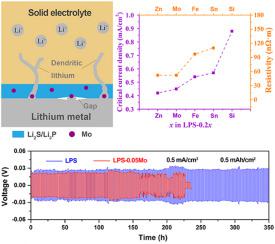Nano Energy ( IF 17.6 ) Pub Date : 2021-02-20 , DOI: 10.1016/j.nanoen.2021.105906 Zhixuan Wang , Yong Jiang , Juan Wu , Yi Jiang , Wencheng Ma , Yaru Shi , Xiaoyu Liu , Bing Zhao , Yi Xu , Jiujun Zhang

|
Doping modification is usually used to improve the ionic conductivity of sulfide solid electrolytes, but its effects on the interface between the electrolyte/lithium (Li) metal seem not sufficiently studied and understood. In this work, the advantages and disadvantages of sulfide electrolyte doped with MoS2, ZnS, FeS2, SnS2 and SiS2 are systematically studied. The ab initio molecular dynamics (AIMD) calculations and experiments show that MoS44- can preferentially replace the P2S74- in Li7P3S11, thereby broadening Li+ channels and creating Li vacancies to promote ion conduction. However, the doping of MoS2 can lead to the introduction of Mo metal into the solid electrolyte/Li interface layer (SEI), resulting in the reduction of the SEI’s interface energy and migration rate of Li atoms at SEI, as well as the accumulation of electrons, thereby accelerating the thickening of the SEI and growth of Li dendrites. The doping results of different sulfides show that the critical current density is positively related to the resistivity of the doping element. The doping of non-metallic silicon will not cause a decrease in the critical current density. This work provides an important reference for the selection of solid electrolyte dopants and the construction of electrolyte/Li interface.
中文翻译:

金属阳离子对硫化物固体电解质/锂金属界面的掺杂作用
掺杂改性通常用于改善硫化物固体电解质的离子电导率,但是似乎对其对电解质/锂(Li)金属之间的界面的影响尚不充分研究和理解。在这项工作中,系统地研究了掺有MoS 2,ZnS,FeS 2,SnS 2和SiS 2的硫化物电解质的优缺点。从头算分子动力学(AIMD)计算和实验表明,MoS 4 4-可以优先取代Li 7 P 3 S 11中的P 2 S 7 4-,从而扩大了Li +通道并形成锂空位以促进离子传导。然而,MoS 2的掺杂会导致将Mo金属引入到固体电解质/ Li界面层(SEI)中,从而导致SEI的界面能和Li原子在SEI处的迁移速率降低,并导致积累电子,从而加速了SEI的增稠和Li树枝状晶体的生长。不同硫化物的掺杂结果表明,临界电流密度与掺杂元素的电阻率呈正相关。非金属硅的掺杂不会导致临界电流密度的降低。这项工作为固体电解质掺杂剂的选择和电解质/ Li界面的构建提供了重要的参考。



























 京公网安备 11010802027423号
京公网安备 11010802027423号